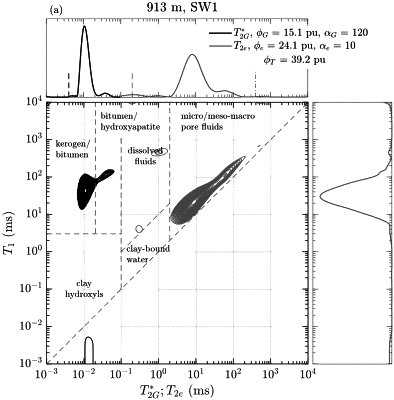| CPC G01N 24/081 (2013.01) [G01R 33/50 (2013.01); G01V 3/32 (2013.01)] | 34 Claims |

|
1. A method of nuclear magnetic resonance (NMR) measurement on a sample, the method comprising:
a) applying a 180° RF pulse to the sample, thereby yielding an inverted longitudinal magnetization Mz=−M0 away from equilibrium;
b) during a selected inversion recovery time τ1, allowing Mz to recover towards an equilibrium value of Mz=M0 governed by a time constant T1;
c) after the selected inversion recovery time τ1, applying a 90° RF pulse for rotating the instantaneous Mz into a transverse plane Mx,y;
d) at a selected pulse-separation time τS, applying a second 90° RF pulse for rotating Mx,y within the transverse plane, creating observable magnetization by formation of a solid-echo;
e) sampling with discretized time steps the observable solid-echo magnetization during a time t following the applying of the second 90° RF pulse to acquire signal amplitude measurements as the observable transverse magnetization decays toward equilibrium with magnetization Mx,y=0, wherein, during the time t, a decay time constant is T*2G;
f) repeating at least once, responsively to a recovery of the sample substantially to equilibrium, steps (a) to (e) with a different selected recovery time τ1 in step (c); and
g) processing the solid-echo measurements to produce a T1-T*2G map for use in characterizing the sample, wherein the characterizing includes at least one of determining a structure and determining a plurality of components.
|